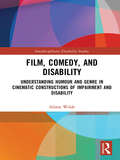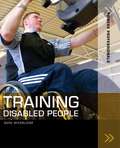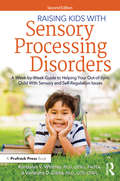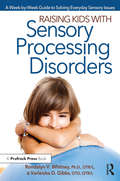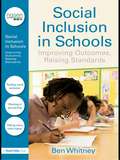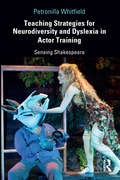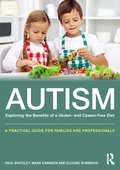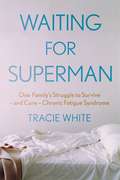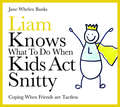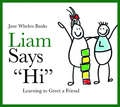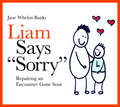- Table View
- List View
Film, Comedy, And Disability: Understanding Humour And Genre In Cinematic Constructions Of Impairment And Disability (Interdisciplinary Disability Studies (PDF))
by Alison WildeComedy and humour have frequently played a key role in disabled people’s lives, for better or for worse. Comedy has also played a crucial part in constructing cultural representations of disability and impairments, contributing to the formation and maintenance of cultural attitudes towards disabled people, and potentially shaping disabled people’s images of themselves. As a complex and often polysemic form of communication, there is a need for greater understanding of the way we make meanings from comedy. This is the first book which explores the specific role of comedic film genres in representations of disability and impairment. Wilde argues that there is a need to explore different ways to synthesise Critical/Disability Studies with Film Studies approaches, and that a better understanding of genre conventions is necessary if we are to understand the conditions of possibility for new representational forms and challenges to ableism. After a discussion of the possibilities of a ‘fusion’ between Disability Studies and Film Studies, and a consideration of the relationships of comedy to disability, Wilde undertakes analysis of contemporary films from the romantic comedy, satire, and gross-out genres. Analysis is focused upon the place of disabled and non-disabled people in particular films, considering visual, audio, and narrative dimensions of representation and the ways they might shape the expectations of film audiences. This book is of particular value to those in Film and Media Studies, and Critical/Disability Studies, especially for those who are investigating more inclusive practices in cultural representation.
Film, Comedy, And Disability: Understanding Humour And Genre In Cinematic Constructions Of Impairment And Disability (Interdisciplinary Disability Studies (PDF))
by Alison WildeComedy and humour have frequently played a key role in disabled people’s lives, for better or for worse. Comedy has also played a crucial part in constructing cultural representations of disability and impairments, contributing to the formation and maintenance of cultural attitudes towards disabled people, and potentially shaping disabled people’s images of themselves. As a complex and often polysemic form of communication, there is a need for greater understanding of the way we make meanings from comedy. This is the first book which explores the specific role of comedic film genres in representations of disability and impairment. Wilde argues that there is a need to explore different ways to synthesise Critical/Disability Studies with Film Studies approaches, and that a better understanding of genre conventions is necessary if we are to understand the conditions of possibility for new representational forms and challenges to ableism. After a discussion of the possibilities of a ‘fusion’ between Disability Studies and Film Studies, and a consideration of the relationships of comedy to disability, Wilde undertakes analysis of contemporary films from the romantic comedy, satire, and gross-out genres. Analysis is focused upon the place of disabled and non-disabled people in particular films, considering visual, audio, and narrative dimensions of representation and the ways they might shape the expectations of film audiences. This book is of particular value to those in Film and Media Studies, and Critical/Disability Studies, especially for those who are investigating more inclusive practices in cultural representation.
Job Success for Persons with Developmental Disabilities
by David WieganIn the USA alone, there are roughly three million individuals living with a developmental disability, but less than a third are active in the labour market. This book provides a comprehensive approach to developing a successful jobs program for persons with developmental disabilities, drawn from the author's extensive experience and real success.
Training Disabled People (Fitness Professionals)
by Sara WicebloomTraining Disabled People is the only book to provide fitnessprofessionals with detailed guidance on working with disabled clients.The book is written to the National Standards, so provides the readerwith everything they need to know in order to gain qualification and beable to work safely and effectively with disabled clients. Training disabled clients is currently the most in-demand course atmany of the fitness industry training centres - they are struggling tokeep up with demand. This follows legislation and Governmentinitiatives designed to improve access to fitness centres for disabledpeople and to encourage them to take part in regular exercise. The book covers a range of areas, including: medical conditions and how to research them programming and instruction skills pre-exercise checks and fitness testing communication skills (including sign language) motivation techniques sample programmes and exercises, fully illustrated with B&W photographychecklists and forms to be used when working with clients.
Training Disabled People (Fitness Professionals)
by Sara WicebloomTraining Disabled People is the only book to provide fitnessprofessionals with detailed guidance on working with disabled clients.The book is written to the National Standards, so provides the readerwith everything they need to know in order to gain qualification and beable to work safely and effectively with disabled clients. Training disabled clients is currently the most in-demand course atmany of the fitness industry training centres - they are struggling tokeep up with demand. This follows legislation and Governmentinitiatives designed to improve access to fitness centres for disabledpeople and to encourage them to take part in regular exercise. The book covers a range of areas, including: medical conditions and how to research them programming and instruction skills pre-exercise checks and fitness testing communication skills (including sign language) motivation techniques sample programmes and exercises, fully illustrated with B&W photographychecklists and forms to be used when working with clients.
How to Be Angry: Strategies to Help Kids Express Anger Constructively
by Signe WhitsonChildren and teenagers often struggle to cope with anger, and angry feelings can boil over into aggression and destructive behaviour. This updated and extended resource takes a different approach to anger, teaching children how to be angry effectively, rather than telling them not to be angry at all.Encouraging appropriate anger management through group work and tailored lessons, the book is also accompanied by downloadable additional resources demonstrating the activities and offering adaptations for parents. Suitable for use with children and teenagers aged 5 - 18, this engaging resource will help children to overcome self-destructive patterns of passive, aggressive, and passive aggressive behaviour.
Raising Kids With Sensory Processing Disorders: A Week-by-Week Guide to Helping Your Out-of-Sync Child With Sensory and Self-Regulation Issues
by Rondalyn V Whitney Varleisha Gibbs Rondalyn L. Whitney Varleisha Gibbs, OTD, OTR/LTaking a look at the most common sensory issues kids face, Raising Kids With Sensory Processing Disorders offers a compilation of unique, proven strategies that parents can implement to help their children move beyond their sensory needs. This updated second edition: Shows parents how to characterize their child's sensory issues into one of several profiles. Helps parents find the best adaptations and changes to their child's everyday routines. Provides a week-by-week series of activities and checklists. Helps improve children's performance on tasks like homework, transitions between activities, and interactions with friends. Is written by parents and occupational therapists. Whether it's having to remove tags from clothing or using special dimmed lighting when they study, kids with sensory disorders or special sensory needs often need adaptations in their everyday lives in order to find success in school and beyond.
Raising Kids With Sensory Processing Disorders: A Week-by-Week Guide to Helping Your Out-of-Sync Child With Sensory and Self-Regulation Issues
by Rondalyn V Whitney Varleisha Gibbs Rondalyn L. Whitney Varleisha Gibbs, OTD, OTR/LTaking a look at the most common sensory issues kids face, Raising Kids With Sensory Processing Disorders offers a compilation of unique, proven strategies that parents can implement to help their children move beyond their sensory needs. This updated second edition: Shows parents how to characterize their child's sensory issues into one of several profiles. Helps parents find the best adaptations and changes to their child's everyday routines. Provides a week-by-week series of activities and checklists. Helps improve children's performance on tasks like homework, transitions between activities, and interactions with friends. Is written by parents and occupational therapists. Whether it's having to remove tags from clothing or using special dimmed lighting when they study, kids with sensory disorders or special sensory needs often need adaptations in their everyday lives in order to find success in school and beyond.
Raising Kids With Sensory Processing Disorders: A Week-by-Week Guide to Solving Everyday Sensory Issues
by Rondalyn V Whitney Varleisha GibbsWhether it's having to remove tags from clothing or using special dimmed lighting when they study, kids with sensory disorders or special sensory needs often need adaptations in their everyday lives in order to find success in school and beyond. Taking a look at the most common sensory issues kids face, Raising Kids with Sensory Processing Disorders offers a compilation of unique, proven strategies parents can implement to help their children move beyond their sensory needs and increase their performance on tasks like homework, field trips, transitions between activities, bedtime, holidays, and interactions with friends. Written by a parent of two children with very different sensory needs, the book shows parents how to characterize their child's sensory issues into one of several profiles that they can then use to find the best adaptations and changes to their everyday routines.
Raising Kids With Sensory Processing Disorders: A Week-by-Week Guide to Solving Everyday Sensory Issues
by Rondalyn V Whitney Varleisha GibbsWhether it's having to remove tags from clothing or using special dimmed lighting when they study, kids with sensory disorders or special sensory needs often need adaptations in their everyday lives in order to find success in school and beyond. Taking a look at the most common sensory issues kids face, Raising Kids with Sensory Processing Disorders offers a compilation of unique, proven strategies parents can implement to help their children move beyond their sensory needs and increase their performance on tasks like homework, field trips, transitions between activities, bedtime, holidays, and interactions with friends. Written by a parent of two children with very different sensory needs, the book shows parents how to characterize their child's sensory issues into one of several profiles that they can then use to find the best adaptations and changes to their everyday routines.
Social Inclusion in Schools: Improving Outcomes, Raising Standards (nasen spotlight)
by Ben WhitneyThis book provides the busy teacher with all the information they need to make social inclusion a reality within schools. By demonstrating how teachers and schools must work together to promote the wider welfare of all children, the book focuses particularly on the welfare of children on the margins of society who need the most protection. It shows how teachers can aim to reduce inequalities and maximise the learning opportunities available for these vulnerable children, whatever their background or social class. The author addresses key issues such as: attendance and achievement exclusion and behaviour safeguarding and child protection children at risk of missing education. By emphasizing the Every Child Matters agenda and the importance of joined-up partnership approaches with other professionals and agencies, this book is essential reading for all practitioners working to support pupils at risk of exclusion.
Social Inclusion in Schools: Improving Outcomes, Raising Standards (nasen spotlight)
by Ben WhitneyThis book provides the busy teacher with all the information they need to make social inclusion a reality within schools. By demonstrating how teachers and schools must work together to promote the wider welfare of all children, the book focuses particularly on the welfare of children on the margins of society who need the most protection. It shows how teachers can aim to reduce inequalities and maximise the learning opportunities available for these vulnerable children, whatever their background or social class. The author addresses key issues such as: attendance and achievement exclusion and behaviour safeguarding and child protection children at risk of missing education. By emphasizing the Every Child Matters agenda and the importance of joined-up partnership approaches with other professionals and agencies, this book is essential reading for all practitioners working to support pupils at risk of exclusion.
Teaching Strategies for Neurodiversity and Dyslexia in Actor Training: Sensing Shakespeare
by Petronilla WhitfieldTeaching Strategies for Neurodiversity and Dyslexia in Actor Training addresses some of the challenges met by acting students with dyslexia and highlights the abilities demonstrated by individuals with specific learning differences in actor training. The book offers six tested teaching strategies, created from practical and theoretical research investigations with dyslexic acting students, using the methodologies of case study and action research. Utilizing Shakespeare’s text as a laboratory of practice and drawing directly from the voices and practical work of the dyslexic students themselves, the book explores: the stress caused by dyslexia and how the teacher might ameliorate it through changes in their practice the theories and discourse surrounding the label of dyslexia the visual, kinaesthetic, and multisensory processing preferences demonstrated by some acting students assessed as dyslexic acting approaches for engaging with Shakespeare’s language, enabling those with dyslexia to develop their authentic voice and abilities a grounding of the words and the meaning of the text through embodied cognition, spatial awareness, and epistemic tools Stanislavski’s method of units and actions and how it can benefit and obstruct the student with dyslexia when working on Shakespeare Interpretive Mnemonics as a memory support and hermeneutic process, and the use of color and drawing towards an autonomy in live performance This book is a valuable resource for voice and actor training, professional performance, and for those who are curious about emancipatory methods that support difference through humanistic teaching philosophies.
Teaching Strategies for Neurodiversity and Dyslexia in Actor Training: Sensing Shakespeare
by Petronilla WhitfieldTeaching Strategies for Neurodiversity and Dyslexia in Actor Training addresses some of the challenges met by acting students with dyslexia and highlights the abilities demonstrated by individuals with specific learning differences in actor training. The book offers six tested teaching strategies, created from practical and theoretical research investigations with dyslexic acting students, using the methodologies of case study and action research. Utilizing Shakespeare’s text as a laboratory of practice and drawing directly from the voices and practical work of the dyslexic students themselves, the book explores: the stress caused by dyslexia and how the teacher might ameliorate it through changes in their practice the theories and discourse surrounding the label of dyslexia the visual, kinaesthetic, and multisensory processing preferences demonstrated by some acting students assessed as dyslexic acting approaches for engaging with Shakespeare’s language, enabling those with dyslexia to develop their authentic voice and abilities a grounding of the words and the meaning of the text through embodied cognition, spatial awareness, and epistemic tools Stanislavski’s method of units and actions and how it can benefit and obstruct the student with dyslexia when working on Shakespeare Interpretive Mnemonics as a memory support and hermeneutic process, and the use of color and drawing towards an autonomy in live performance This book is a valuable resource for voice and actor training, professional performance, and for those who are curious about emancipatory methods that support difference through humanistic teaching philosophies.
Autism: A practical guide for families and professionals
by Paul Whiteley Mark Earnden Elouise RobinsonAutism represents one of the biggest health challenges facing children today. Whilst experts around the globe strive to unravel and truly understand how autism develops and presents itself, relatively little is still known about the condition. Meanwhile, strong evidence has emerged that the diet in children on the autistic spectrum can have a significant role to play in the management of their symptoms. A growing body of research reveals that some challenging characteristics present in autism may be positively affected by the introduction of a gluten- and casein-free (GFCF) diet. Autism: Exploring the benefits of a gluten and casein free diet offers an easy-to-read alternative to sifting through the science. Written by experts in autism research, food, nutrition and dietetics, the book cuts through the science-speak to offer readers a no-nonsense overview of diet and autism together with a range of useful recipes and handy hints for making mealtimes fun for children with autism and related conditions.
Autism: A practical guide for families and professionals
by Paul Whiteley Mark Earnden Elouise RobinsonAutism represents one of the biggest health challenges facing children today. Whilst experts around the globe strive to unravel and truly understand how autism develops and presents itself, relatively little is still known about the condition. Meanwhile, strong evidence has emerged that the diet in children on the autistic spectrum can have a significant role to play in the management of their symptoms. A growing body of research reveals that some challenging characteristics present in autism may be positively affected by the introduction of a gluten- and casein-free (GFCF) diet. Autism: Exploring the benefits of a gluten and casein free diet offers an easy-to-read alternative to sifting through the science. Written by experts in autism research, food, nutrition and dietetics, the book cuts through the science-speak to offer readers a no-nonsense overview of diet and autism together with a range of useful recipes and handy hints for making mealtimes fun for children with autism and related conditions.
Waiting For Superman: One Family's Struggle to Survive – and Cure – Chronic Fatigue Syndrome
by Tracie WhiteFor the past six years, Whitney Dafoe has been confined to a bedroom in the back of his parents' home, unable to walk, eat or speak. His diagnosis? The mysterious disease myalgic encephalomyelitis or chronic fatigue syndrome (ME/CFS) which affects 20 million people around the world who largely suffer in silence because the condition is little known and much misunderstood. Waiting for Superman follows Whitney's father, groundbreaking geneticist Ron Davis, as he uncovers new possibilities for treatments and potentially a cure. At its heart, this book is about more than just cutting-edge research or a race to find an answer - it's about the lengths to which a parent will go to save their child's life.
The Social Play Record: A Toolkit for Assessing and Developing Social Play from Infancy to Adolescence (PDF)
by Chris WhiteSocial play is about relating to others, playing and making friends - all of which are key elements for social inclusion, adjustment and well-being. The Social Play Record is a practical resource for assessing and developing social play in children with autistic spectrum disorders (ASDs) or difficulties with social interaction. This toolkit is designed to be used collaboratively with children, parents, carers and practitioners. It is suitable for assessing children of all learning abilities and stages of development, from early infancy to adolescence, and includes photocopiable assessment and intervention materials. The toolkit is divided into user-friendly sections, including: * a guidance section, which also gives information on what constitutes social play, its significance, development and how to address social interaction difficulties * an assessment section for recording stages of social play and key abilities, such as independent and peer play, friendship and advanced group skills * an intervention section, which gives step-by-step directions for developing key social play skills. Parents, teachers and professionals working with or caring for a child with social interaction difficulties will find this toolkit an essential assessment resource.
Liam Goes Poo in the Toilet: A Story about Trouble with Toilet Training
by Jane Whelen-BanksLiam Goes Poo in the Toilet illustrates the relationship between eating and excreting. It provides visual instructions on how to "relax and push". After much fanfare, Liam finally masters going 'poo' in the toilet, and both he and Mum bask in the glory of a job well done.
Liam Knows What To Do When Kids Act Snitty: Coping When Friends are Tactless
by Jane Whelen-BanksLiam is a very talented boy. He can do lots of neat things, like tricks, tumbles and freaky faces. One day, Liam decided to impress his friend Sarah with a super-duper somersault on the couch. Sara said: 'So?' In Liam Knows What to do When Kids Act Snitty, lovable Liam finds out why his amazing feats of greatness are sometimes met with snide or snitty responses. He learns that when kids are snitty, it does not mean they don't like you, or that your tricks are boring, but that they haven't yet learnt how to be gracious and polite. Vibrant, colourful and lively, this book's positive messages and advice are ideal for young children wanting to understand social situations or how friendships work.
Liam Knows What To Do When Kids Act Snitty: Coping When Friends are Tactless (PDF)
by Jane Whelen-BanksLiam is a very talented boy. He can do lots of neat things, like tricks, tumbles and freaky faces. One day, Liam decided to impress his friend Sarah with a super-duper somersault on the couch. Sara said: 'So?' In Liam Knows What to do When Kids Act Snitty, lovable Liam finds out why his amazing feats of greatness are sometimes met with snide or snitty responses. He learns that when kids are snitty, it does not mean they don't like you, or that your tricks are boring, but that they haven't yet learnt how to be gracious and polite. Vibrant, colourful and lively, this book's positive messages and advice are ideal for young children wanting to understand social situations or how friendships work.
Liam Says "Hi": Learning to Greet a Friend
by Jane Whelen-BanksThis is Liam. Liam has lots of friends who love him and want to play with him. When we get together with friends, we greet them by looking at their face and saying, 'Hi'. We don't look down or look away and say nothing. We don't run off when friends arrive. They will think they don't want to play with us! Introductions can be awkward for many children. For some, however, making eye contact, and acknowledging another person by simply saying "hi" can be a constant challenge. In Liam Says "Hi" Liam manages to overcome his shyness and greet his friend at the door leading to an excellent play date. Vibrant, colourful and lively, this is a lovely, friendly storybook for explaining friendships to young children aged 4+.
Liam Says "Hi": Learning to Greet a Friend (PDF)
by Jane Whelen-BanksThis is Liam. Liam has lots of friends who love him and want to play with him. When we get together with friends, we greet them by looking at their face and saying, 'Hi'. We don't look down or look away and say nothing. We don't run off when friends arrive. They will think they don't want to play with us! Introductions can be awkward for many children. For some, however, making eye contact, and acknowledging another person by simply saying "hi" can be a constant challenge. In Liam Says "Hi" Liam manages to overcome his shyness and greet his friend at the door leading to an excellent play date. Vibrant, colourful and lively, this is a lovely, friendly storybook for explaining friendships to young children aged 4+.
Liam Says "Sorry": Repairing an Encounter Gone Sour
by Jane Whelen-BanksLiam has a wonderful big brother called Jamie. Liam and Jamie play lots of fun things together, like computer battle games, sword fighting and pillow boffing. Liam's favourite game though is wrestling. One day when they were wrestling, Jamie had Liam pinned on the ground. Liam got frustrated and whacked Jamie on the nose. Making mistakes goes hand in hand with learning. It is a fact of life to which none of us are immune. Yet it is not our mistakes but how we deal with them that truly defines who we are. In Liam Says "Sorry" Liam impulsively whacks his brother on the nose and ruins an otherwise joyful round of wrestling. Wanting desperately to resume the game and win favour with his brother, Liam accepts responsibility for his blunder and apologises. His brother forgives him, and apologises too and the wrestling at last can be resumed. Good job Liam! Vibrant, colourful and lively, this book's positive messages and advice are ideal for young children wanting to understand social situations or how friendships work.
Liam Says "Sorry": Repairing an Encounter Gone Sour (PDF)
by Jane Whelen-BanksLiam has a wonderful big brother called Jamie. Liam and Jamie play lots of fun things together, like computer battle games, sword fighting and pillow boffing. Liam's favourite game though is wrestling. One day when they were wrestling, Jamie had Liam pinned on the ground. Liam got frustrated and whacked Jamie on the nose. Making mistakes goes hand in hand with learning. It is a fact of life to which none of us are immune. Yet it is not our mistakes but how we deal with them that truly defines who we are. In Liam Says "Sorry" Liam impulsively whacks his brother on the nose and ruins an otherwise joyful round of wrestling. Wanting desperately to resume the game and win favour with his brother, Liam accepts responsibility for his blunder and apologises. His brother forgives him, and apologises too and the wrestling at last can be resumed. Good job Liam! Vibrant, colourful and lively, this book's positive messages and advice are ideal for young children wanting to understand social situations or how friendships work.
